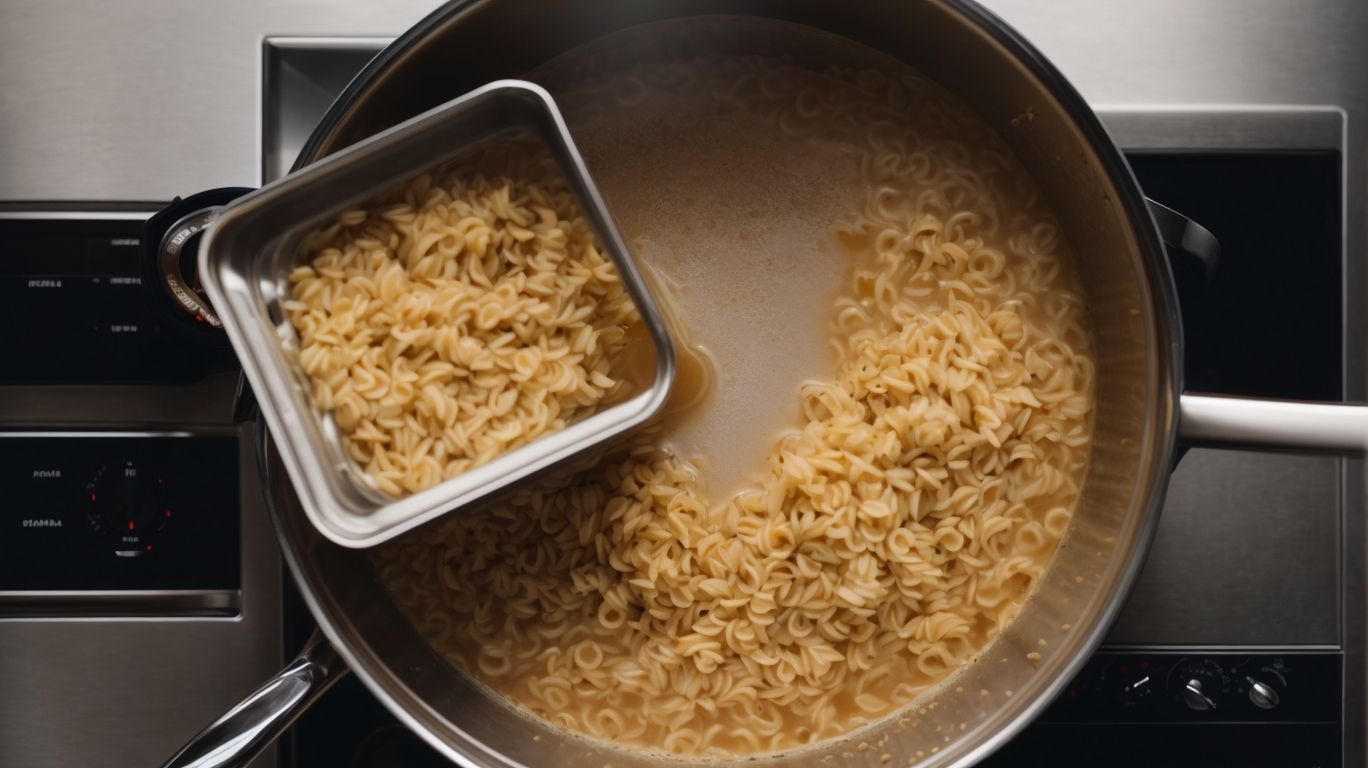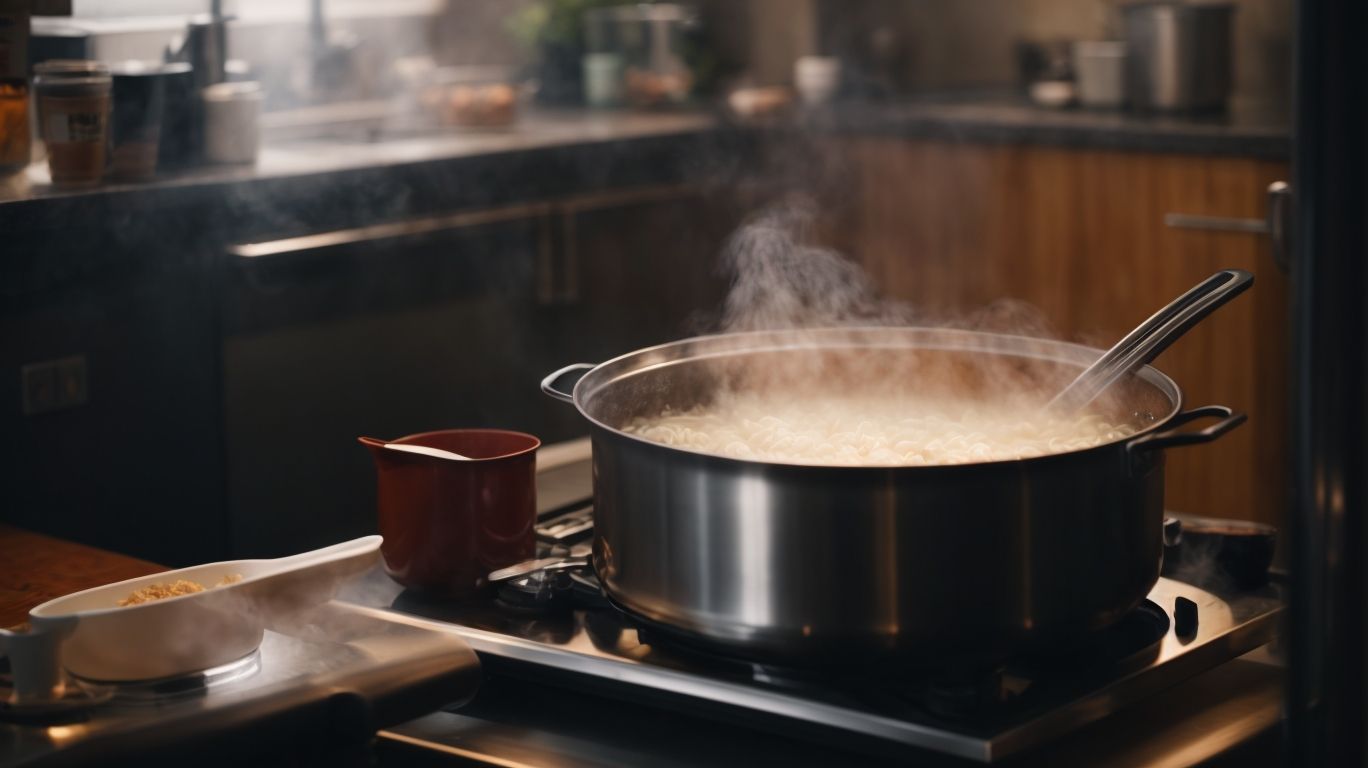How to Cook Ramen Noodles on the Stove?
Are you craving a hot and comforting bowl of ramen noodles but not sure how to make them from scratch? Look no further!
Learn the step-by-step process of cooking delicious ramen noodles on the stove. From the essential ingredients you need to helpful tips for perfecting your noodles, we’ve got you covered.
Grab your apron and get ready to impress your taste buds with a homemade bowl of ramen goodness!
Key Takeaways:
What Ingredients Do You Need?
Creating a delicious bowl of ramen requires a few key ingredients and the right balance of flavors and textures.
In terms of making your own ramen at home, the possibilities are endless. To begin, you’ll need a base like miso, shoyu, or tonkotsu broth. Next, incorporate noodles – whether it’s traditional wavy noodles or thicker, chewier ones for a heartier bite. Don’t forget to add in your protein of choice, like slices of pork belly, chicken, or tofu for a vegetarian twist. Adjusting the seasoning is crucial, a dash of soy sauce, a sprinkle of furikake, or a squeeze of citrus can elevate the flavors. Top off your creation with soft-boiled eggs, seaweed, spring onions, and a drizzle of sesame oil for that final touch of authenticity.
Ramen Noodles
The foundation of any good ramen dish is the noodles, which come in various shapes, textures, and sizes to elevate the overall experience.
In terms of selecting ramen noodles, opting for high-quality ones can make a significant difference in the overall taste and enjoyment of the dish. Premium ramen noodles are often made from a blend of wheat flour, water, salt, and an alkaline mineral water called kansui, which gives the noodles their signature springy texture.
Whether you prefer thin and straight Hakata-style noodles, wavy and thick curly noodles, or flat and wide Tokyo-style noodles, the type of noodle you choose can greatly impact the mouthfeel and flavor of your ramen.
Broth or Seasoning Packet
The broth or seasoning packet is the soul of the ramen, infusing the noodles with rich flavors and creating a harmonious taste profile.
Choosing the right broth or seasoning packet can entirely transform the dining experience. Whether you prefer a classic miso broth with its savory umami notes, a spicy kimchi-infused seasoning for a kick, or a comforting chicken broth that soothes the soul, each option brings its unique character to the bowl of noodles.
Flavor profiles vary from the subtle and delicate to the bold and fiery, catering to diverse palates and preferences.
Water
Water is a fundamental component in the ramen cooking process, essential for boiling the noodles and preparing the broth or seasoning.
When boiling the noodles, the quality of the water used can greatly impact the overall flavor of the dish. Water serves as the base for the broth, extracting flavors from ingredients like miso, soy sauce, and dashi. It plays a crucial role in achieving the desired consistency of the broth, whether you prefer it light and clear or rich and creamy. The amount and type of water you use can make a significant difference in the final taste and texture of your ramen, making it a key ingredient to pay attention to during the cooking process.
Optional Toppings
Toppings such as eggs, spice packets, and vegetable mixes can elevate your ramen to a gourmet meal, adding both texture and nutrition.
For those looking to enhance the protein content of their ramen bowls, options like succulent slices of pork belly, tender chicken breast, or even tofu can provide a hearty and satisfying element to the dish. These protein toppings not only add substance but also infuse various flavors – from the rich umami of pork to the savory notes of grilled chicken or the mild taste of tofu.
To add some crunch and freshness, crunchy bean sprouts, sliced scallions, or crisp seaweed can create a contrast in textures, making each bite interesting and dynamic. These vegetable toppings not only contribute to the nutritional value of the meal but also offer a burst of color and freshness to the overall presentation of the dish.
Step-by-Step Guide to Cooking Ramen Noodles on the Stove

Credits: Poormet.Com – Christian Jones
Cooking ramen noodles on the stove is a simple yet rewarding process that involves boiling water, preparing the noodles, and assembling the perfect bowl of flavorful goodness.
Start by filling a medium-sized pot with water and bringing it to a rolling boil over high heat. Once the water is boiling, carefully add the ramen noodles to the pot. Allow the noodles to cook for about 2-3 minutes until they are tender but still slightly firm.
In another pot, prepare the broth by heating it gently over low heat. You can customize your broth by adding sesame oil, soy sauce, miso paste, or other seasonings to enhance the flavor.
Once the noodles are cooked, drain them and rinse with cold water to stop the cooking process. Then, add the noodles to a serving bowl and pour the hot broth over them.
Boil Water
The first step in cooking ramen noodles is to bring a pot of water to a rolling boil, ensuring that the noodles will cook evenly and retain their texture.
To achieve a rolling boil, place a pot filled with an adequate amount of water on the stove over high heat. It’s essential to cover the pot with a lid to speed up the boiling process and conserve energy. Watch the water as it heats up; tiny bubbles will form at the bottom and sides first. Once the water reaches a vigorous, rolling boil with large bubbles continuously breaking the surface, it’s ready for the noodles.
Add Noodles
Once the water reaches a boil, add the ramen noodles to the pot, gently separating them to prevent clumping and ensuring even cooking.
It is crucial to add the noodles in a slow and steady manner to avoid splashback and potential burns.
By using a pair of chopsticks or a fork, delicately stir the noodles once they are submerged in the water, ensuring they do not stick together.
Allow the noodles to cook for the recommended time specified on the package, typically around 3-4 minutes for instant ramen noodles.
This ensures that the noodles reach the perfect level of tenderness without becoming mushy or overly soft.
Cook for 3 Minutes
Allow the noodles to cook for approximately 3 minutes, ensuring they reach the desired texture while absorbing the flavors of the broth or seasoning.
Although it may be tempting to overcook the noodles, sticking to the recommended time will maintain their firmness or softness based on personal preference. Cooking time can greatly impact the overall dish; a longer duration might result in mushy noodles, while a shorter time could yield an undesirable firmness. For a perfect balance, use a timer to precisely track the cooking process.
Drain Noodles
After cooking, drain the noodles well to remove excess water and maintain their desired texture, ready to be combined with the flavorful broth.
Properly draining the noodles is a crucial step in ensuring they don’t become soggy. When noodles are overcooked or not drained properly, they can absorb excess moisture, resulting in a mushy texture that can ruin the dish’s overall taste and appearance.
To achieve perfectly cooked noodles, consider investing in a high-quality colander or strainer with small perforations to prevent any noodles from slipping through during the draining process. Gently shaking the colander can help remove any lingering water, leaving you with beautifully cooked noodles that are ideal for soaking up the broth’s flavors.
Prepare Broth or Seasoning Packet
While the noodles cook, prepare the broth or seasoning packet according to the directions, ensuring a balanced and flavorful base for your ramen dish.
For the broth, you can either use pre-made broth or opt for a homemade version for a more personalized touch. If using store-bought broth, consider enhancing its flavor by simmering it with aromatics such as garlic, ginger, and scallions. To create your own broth, simmer vegetables like onions, carrots, and mushrooms with water, soy sauce, and a touch of miso paste for depth of flavor. When working with a seasoning packet, taste it first to gauge its saltiness and adjust accordingly by adding water or diluting it with more broth. Whether you choose a classic or customized approach, a well-prepared broth elevates the overall taste experience of your ramen.
Add Noodles to Broth
Combine the cooked noodles with the prepared broth, allowing them to soak up the flavors and develop a harmonious texture profile.
By immersing the noodles in the broth, each strand absorbs the savory essence, creating a delectable amalgamation of taste. Flavor infusion occurs as the noodle fibers expand and take on the rich broth’s character, resulting in a symphony of flavors with every bite. This careful mingling of components enhances both the noodle’s tenderness and the broth’s depth, ensuring a satisfying dining experience. The gradual melding of textures and tastes showcases the art of noodle-broth integration, culminating in a delightful masterpiece for the palate.
Garnish with Toppings
Finish your ramen masterpiece by garnishing with your favorite toppings such as eggs, vegetables, or seeds, enhancing both the visual appeal and taste.
Adding fresh herbs like cilantro or green onions can introduce a burst of freshness to the dish.
For a textural contrast, try crispy fried shallots or crunchy nori strips.
Don’t forget the protein – tender slices of braised pork belly or marinated tofu cubes can take your ramen to the next level.
A drizzle of sesame oil or a sprinkle of toasted sesame seeds can elevate the overall umami flavor profile.
Experiment with different combinations to create a personalized ramen bowl that suits your taste preferences!
Tips and Tricks for Perfect Ramen Noodles
Mastering the art of preparing perfect ramen noodles involves various tips and creative tricks to elevate your culinary experience with plant-based protein options and flavorful toppings.
One innovative tip to boost the protein content in your ramen dish is by adding tofu or tempeh as a meatless alternative. These plant-based options not only provide a substantial source of protein but also bring a unique texture to your noodle bowl.
Consider experimenting with a variety of vegetables such as bok choy, shiitake mushrooms, and bean sprouts as colorful and nutritious toppings to enhance both the visual appeal and nutritional value of your ramen creation.
Use High-Quality Noodles
Opt for high-quality noodles to enhance the overall texture and taste of your ramen dish, ensuring a satisfying and authentic experience.
In terms of creating a delicious bowl of ramen, the key lies in the choice of noodles you use. Premium noodles are crucial in achieving the desired texture and flavor profile that can truly elevate your culinary masterpiece. By opting for top-notch noodles, you are not only ensuring a superior eating experience but also laying the foundation for an authentic and delightful dish. These high-quality noodles have the ability to absorb the rich broth and complement the toppings, resulting in a harmonious blend of flavors and textures that will leave your taste buds craving for more.
Add Vegetables for Extra Flavor and Nutrition
Incorporate a variety of fresh vegetables into your ramen for added flavor complexity and nutritional benefits, creating a wholesome and vibrant dish.
Vegetables not only elevate the taste profile of your ramen but also pack a punch in terms of health benefits. Leafy greens like spinach or bok choy can add a pop of color and a dose of vitamins. Carrots bring sweetness to the broth, while mushrooms provide a rich umami flavor. For a spicy kick, consider adding sliced jalapenos or bell peppers. The crunch of bean sprouts or the earthy notes of bamboo shoots can also enhance the overall texture of your dish.
Experiment with Different Broth Flavors
Explore a world of culinary possibilities by experimenting with diverse broth flavors, ranging from traditional to innovative combinations, to customize your ramen experience.
Embrace the rich umami depth of miso broth or the comforting warmth of a classic tonkotsu base. For a twist, consider the complex layers of seafood-based broths like shoyu or the tangy brightness of a vegetarian dashi. Broth variations inject character into your ramen bowl, offering the chance to tailor each spoonful to your preferences. The choice of broth can elevate or transform the entire dish, influencing the interplay of flavors and textures in every slurp. Dare to experiment and unlock the full potential of your personalized ramen creation!
Don’t Overcook the Noodles
To achieve the perfect ramen texture, avoid overcooking the noodles, as they should be firm yet tender, adding to the overall enjoyment of the dish.
Proper noodle cooking times are crucial in the delicate art of preparing the ideal bowl of ramen. Overcooked noodles can become mushy, losing their desirable chewiness and becoming an unwelcome distraction in each savory bite. To prevent this, it’s recommended to closely follow the cooking instructions provided on the noodle packaging, ensuring they are just tender enough without being too soft.
Consistency is key when it comes to noodle perfection. Different types of noodles require different cooking times, so adjusting accordingly is vital for achieving the desired texture. By mastering these nuances, you can preserve the integrity of the noodles and elevate your ramen experience to new heights.
Conclusion

Credits: Poormet.Com – Michael Baker
Mastering the art of preparing ramen noodles opens up a world of culinary possibilities, allowing you to customize flavors, textures, and ingredients to create a delightful meal experience.
When perfecting your homemade ramen, taste, this critical element, should not be compromised. Achieving a balance between savory, umami-rich broth and tender noodles is key.
Experiment with various seasonings such as soy sauce, miso, and garlic to enhance the flavor combinations.
Paying attention to the texture of your noodles is crucial. Whether opting for chewy, firm noodles or something softer, the texture plays a significant role in the overall satisfaction of the dish.
Frequently Asked Questions
How to Cook Ramen Noodles on the Stove?
To cook ramen noodles on the stove, start by boiling water in a pot. Once the water is boiling, add the ramen noodles and cook for 3 minutes while stirring occasionally.
Can I add vegetables to my ramen noodles while cooking?
Yes, you can add vegetables such as carrots, mushrooms, and bok choy to your ramen noodles while cooking for added flavor and nutrition. Simply chop the vegetables and add them to the pot along with the noodles.
How much water should I use to cook ramen noodles on the stove?
The general rule is to use 2 cups of water per 1 cup of noodles. However, you can adjust the amount of water depending on your desired consistency and texture of the noodles.
Do I need to drain the water after cooking ramen noodles on the stove?
It is not necessary to drain the water after cooking ramen noodles on the stove. In fact, the starchy water can add flavor and help thicken the broth of your ramen.
Can I use any type of pot to cook ramen noodles on the stove?
It is recommended to use a deep pot with a lid to cook ramen noodles on the stove. This allows for enough water to cover the noodles and a lid to trap heat and cook the noodles evenly.
Can I cook ramen noodles on the stove without the seasoning packet?
Yes, you can cook ramen noodles on the stove without the seasoning packet. Instead, you can use your own broth or stir-fry vegetables and protein with the noodles for a healthier and more flavorful option.




